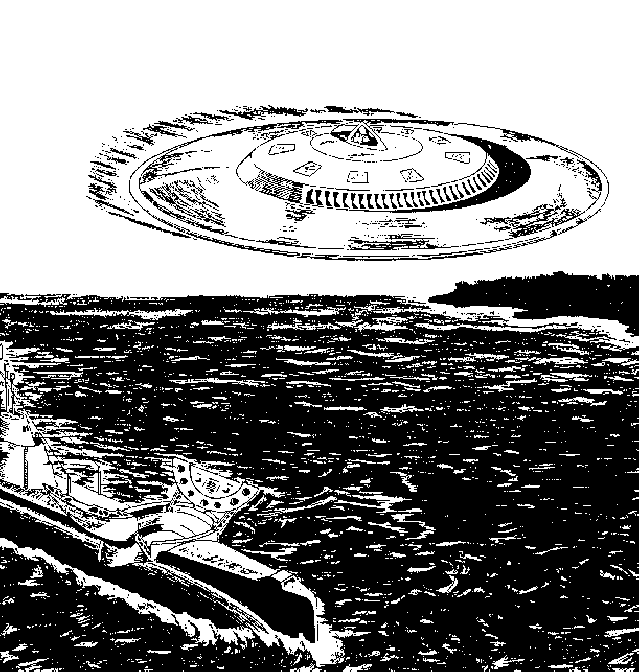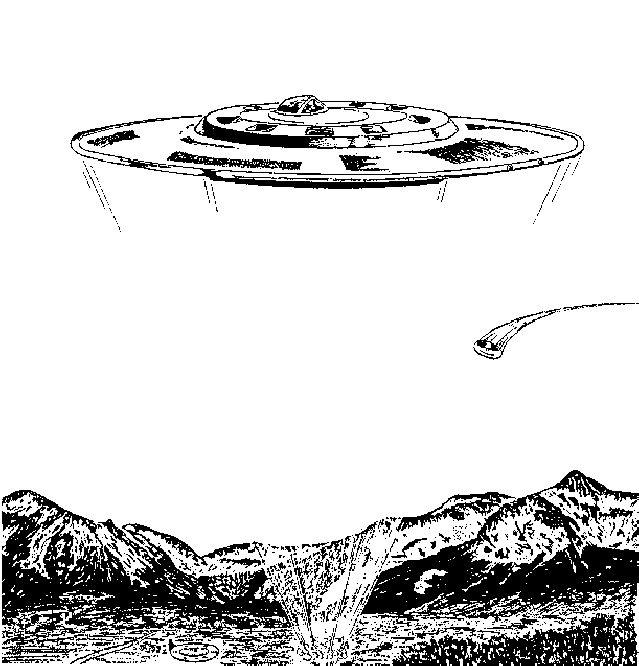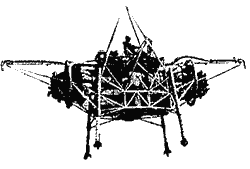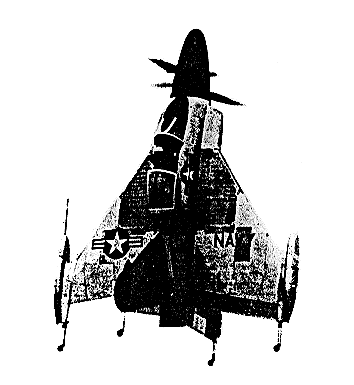(This document is reproduced with the kind permission of CUFON)
AIR INTELLIGENCE DIGEST
DECEMBER 1954 Volume 7 - Number 12
WARNING: this document contains information affecting the national defense of the United States within the meaning of the Espionage Laws, Title 18 U.S.C., Section 793 and Section 794. Its transmission or the revelation of its contents in any manner to an unauthorized person is prohibited by law. Reproduction of the intelligence in this publication and numbered distribution in local series are authorized when total additional distribution list is furnished the issuing office, Directorate of Intelligence, DCS/O Hq, USAF, Pentagon. Printed for official use with the approval of the Bureau of the Budget, 31 Oct. 1951 Over-all classification of this document is SECRET
EDITOR'S NOTES
Flying Discs in the Air Intelligence Digest
When you come to page 6, don't close the book because you think the AIR INTELLIGENCE DIGEST has flipped its lid. We have not joined the ranks of publications that print speculative stories of strange flying contraptions, nor have we had any polka-dotted strangers from outer space visiting our office. This is for real. A new aircraft configuration with a circular planform is taking shape on the drawing boards of Western aircraft designers that may well be the beginning of a new era of flight....
FIVE YEARS FROM NOW: THE FLYING DISC
New type of jet aircraft, powered by a turbine larger than any now in use, is expected to take off, land vertically, and be able to hover. It may cruise at 1,500 knots and have a range of 15,000 nautical miles. Aircraft designers may be approaching the era of the Earth-built flying saucer. Latest information indicates that a turbine-powered, circular-shaped jet aircraft - literally a flying turbojet engine - will be in existence in the West just 5 years from now. No such aircraft have yet flown, but an experimental project is actively under way in the Western Hemisphere. Such a machine may turn out to be a formidable weapon capable of traveling so fast and so high that it will be virtually immune from attack by present-day defense systems.

WEAPON OF 1960? This is a very-much-generalized chart (not reflecting estimates) to suggest the possibilities of the future as far as a proposed flying disc is concerned. This artist's conception is printed as a conversation piece, to rouse speculation whether a flying disc might fly so high, and so fast that air-to-air missiles, and anti-aircraft guns would not be able to match its performance and bring it down

[SECRET] DISC AND SUB could make a deadly combination in an offensive operation. Submarine could approach enemy's mainland and let disc take off. In space of half hour, disc could fly 300 miles, hit target, return to submarine [SECRET]
If the developments now under way culminate in successful flight -- and the chances are considered good that they will - the disc-shaped aircraft is expected to be able to take off and land vertically, to be able to hover, and to travel at speeds and altitudes than those possible to attain now with conventional wing-and-fuselage jet aircraft. In addition, the range of a disc-type bomber may be greater than that of present-day bombers. A possibility so startling immediately poses a multitude of questions. This article will attempt to answer some of the questions, but will not attempt a detailed coverage.

NO RUNWAYS NEEDED. Disc would not need runway for take-offs and landings. It could get up close to enemy, rise from small clearing and hit deep, fast, hard. It might be less costly to build than today's jet aircraft. [SECRET]
* Why will this aircraft have the shape of a disc? The disc configuration permits equal distribution of radially directed thrust about the circumference, thereby permitting vertical take-off in the horizontal attitude. This shape also lends itself to the housing of the powerplant configuration planned for the aircraft.
* Where will the pilot (or crew in a bomber-size disc) be carried? The pilot probably will be housed in a compartment mounted in the top center part of the disc. Such a compartment will probably be provided with a full complement of flight instruments, some of which may be specially designed to meet the requirements of unusual flight characteristics.
* How will the pilot steer the disc? In the main, he will control it by simply by changing the thrust distribution. At various places on the rim of the aircraft, variable exhaust orifices may be opened or closed to change the direction and/or location of the thrust resultant. When necessary, the pilot may vary the amount of thrust as he changes direction and thereby avoid a too-severe G load. A successful development of a saucer aircraft would compel military planners in both hemispheres to take a new look at the design or planned procurement of many items of military equipment such as radars, guided missiles, aircraft armament, antiaircraft artillery, aircraft carriers, helicopters, blimps, and airfields. Further, if the expected potential of the disc type design becomes a reality, it will represent an historic break-through to a level of engineering and flight progress that has been predicted for centuries, and it will revolutionize aircraft design and air warfare. The full impact of the effect that a disc aircraft might have on the planning and conduct of defensive and offensive military operations is apparent when we consider some of the operations characteristics that appear to be within the capabilities of this proposed new configuration. Let's consider three likely sizes - large, medium and small - and examine the estimated capabilities of each size:
LARGE SIZE This type could be used as a long-range bomber, as a carrier of personnel or cargo, as an ambulance, as a reconnaissance vehicle, as a fuel tanker and a refueling ship, or as a guided missile.
Diameter 100 feet
Thickness 20 feet
Speed 1,500 knots
Maximum altitude 90,000 feet
Range 15,000 n.m.
Cruise altitude 65,000 feet
MEDIUM SIZE This type could be used as a fighter interceptor, as a ground-support aircraft, or as a guided missile.
Diameter 30 feet
Thickness 7 feet
Speed 1,500 knots
Maximum altitude 90,000 feet
Cruise altitude 65,000 feet
Range 15,000 n.m.
SMALL SIZE This type could be used as a guided missile.
Diameter down to 6 feet
Thickness down to 2 feet
Speed 1,000 knots
Maximum altitude 90,000 feet
Range 20 to 100 n.m.
One of the big questions now facing the United States is this: What are the Soviets doing in the disc-aircraft field? If the United States accepts the possibility of success of circular-shaped aircraft, then it must also conclude that the Soviet Union is capable of developing such aircraft. If readers assume, at the extreme end of the possibility scale, that the USSR is several years ahead right now, these questions must occur to them
* If the Soviets now have such an aircraft in operational use, would the United States air defense system be able to detect, identify, intercept and destroy a bomber or reconnaissance aircraft moving at a 1,500 knot clip at an altitude of 65,000 feet?

HOAX. Faked picture of disc aircraft originated in South America in May 1952. Spurious disc is strangely like that described in this article. [UNCLASSIFIED]
* What would be the capability of the Strategic Air command with present-day aircraft to penetrate the Soviet union on bombing missions if the Soviets defended themselves with disc-type interceptor aircraft with the above performance?
VTOs, 1954. Here are two vertical take-off aircraft.

Above is the British experimental "Flying Bedstead," as homely a creation as ever rolled out of a hangar. In tethered flight, it went up and down to prove that jet thrust could be used for vertical take-off and landing. Below is U.S. Navy's XFY 1, which has been test-flown successfully in vertical and horizontal flight. [UNCLASSIFIED]

Discs could take off from land or sea. It is worth repeating that the disc aircraft is a vertical riser. (Some day it may be known simply as a VTO, or vertical take-off aircraft.) This means that it could be housed aboard most naval ships, including submarines. Obviously, a disc aircraft and a sub would make a deadly combination in an offensive operation. It is estimated that in the space of 30 minutes, a disc could take off from its nesting place on the deck of a sub, climb to 65,000 feet or higher, make a run on a target area 200 to 300 miles inland, drop its bomb load, and zip back home to the sub. Such an aircraft would need no long, heavily reinforced concrete runways. At the most, it would only need a concrete platform to keep ground personnel and installations from being hit with dust, sand, or gravel. In many instances, a small clearing could provide the disc with a take-off spot.
Conclusion: Heads Up! A great amount of information on the development , flight, and production of circular-type aircraft will be reported and discussed during the next few years. It will behoove the USAF to continue its open-minded interest in all such reports, keeping in mind that reports of saucer-shaped aircraft have an increasingly better chance of being true as the years go by. A new era of flight appears about to begin.